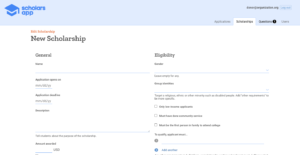Ballooning college loan debt has been a pressing issue for Americans seeking higher education. The crippling weight of college loans on recent graduates has reached critical levels, making education almost inaccessible for a large part of the population. In its annual survey, U.S. News found that college graduates from the class of 2020 borrowed $29,927 on average to fund their education. That is a 20 percent increase compared to the amount borrowed by graduates in 2010 (5 percent over the rate of inflation).
The much higher cost of education is pushing the majority of families to seek scholarships to help pay for college. If you’re looking to help your community, a digital scholarship is one of the best ways – but how do you start one?
Launching a Fully Digital Scholarship in 5 Steps
In 2020, the average scholarship award was $7,923, covering about 19 percent of college costs. This highlights the room available for more online scholarships for those pursuing higher education. Thankfully, setting up a scholarship fund is now easier than ever, partly due to digital scholarship platforms.
Here’s your five-step checklist for launching a fully digital scholarship in 2022:
1. Decide on the Award Amount
You likely already have a rough figure in mind but before finalizing, you need to consider other factors that may increase the total cost of setting up a digital scholarship fund. These include the cost of legal fees, hiring staff, setting up a website, reviewing applicants, and promoting and awarding the scholarship.
We’ll dive deeper into some of the costs in this article but know that you don’t need a massive scholarship fund to make a difference. While traditional scholarships are usually created with a minimum budget of $20,000, digital scholarships can be started with much less capital due to a significantly reduced administrative overhead.
2. Understand State Laws and Regulations
Since there is no federal regulatory body that oversees scholarship funds, the laws governing the distribution of scholarships vary by state. The laws that affect starting a scholarship fund the most, however, revolve around the IRS.
The IRS has guidelines for who can and cannot receive scholarships and how a scholarship is awarded (in terms of procedure). For example, a scholarship is tax-deductible for its donors, given that the scholarship is awarded on an “objective and nondiscriminatory basis”.
Other points to note:
- Selection of the recipient from among the candidates should be related to the purpose(s) of the scholarship.
- If the award is made directly to the student, the foundation must receive a report of his/her courses and grades from the educational institution at least once a year.
- Scholarships should not be awarded to insiders, like members of the selection committee, or to their family members.
It’s recommended you speak with an expert as you go through setting up the fund to ensure you have a clear picture of the tax implication of each option.
We’ll also list resources for additional reading on laws and regulations affecting scholarship funds at the end of this guide.
3. Determine the Eligibility Criteria
While determining the eligibility criteria for the scholarship, consider who you want to help. There are different types of scholarships targeted to different student groups, including (but not limited to):
- merit-based scholarships
- athletic scholarships
- Need-based scholarships
- employer and military scholarships
The type of scholarship you choose will affect the eligibility criteria potential candidates will have to meet. Here are some things that may be helpful in making this decision:
- Some programs have more access to scholarships than others – 17 percent of STEM students are awarded scholarships, while 12.1 percent of non-STEM students receive them.
- Middle-income students are awarded more scholarships than low-income students: 13.8 percent of middle-income students are awarded scholarships vs. 10.6 of low-income students receive them.
- Students in private institutions receive more merit scholarships: 18 percent of public university students receive merit scholarships vs. 25 percent of private university students.
To make a true impact, consider awarding scholarships to groups of students less likely to receive funding. Not to mention, creating a scholarship fund for an oversaturated field of interest may lead to fewer applicants.
4. Set the Duration of the Fund
There are many options available when it comes to deciding the duration of the fund or award period. The scholarship could be a large sum that is distributed on a monthly or yearly basis. It could also be a one-time award. Another option is an award that can be renewed yearly.
The right choice for your online scholarship depends on your goals. Do you want to ensure a recipient is supported throughout the length of their degree or do you want to award the fund to as many different people as possible? For instance, areas of study that are generally longer (such as STEM fields) could use a longer duration of the fund. On the other hand, students in fields that have a relatively short study period (such as welding, art, business) may benefit more from a one-time award.
5. Promote your Digital Scholarship
An important step to the success of your scholarship is making sure eligible students know about it. There are many sites scholarship providers can use to attract a wide variety of applicants. For instance, Scholar’s App offers a complete end-to-end platform for listing and promoting (as well as reviewing and awarding) scholarships.
There are also other cost-effective (but not free) ways of promoting a scholarship including pay-per-click (PPC) advertising on Google, Facebook, Instagram, etc. Scholarship providers can also bring a large viewership without any additional costs through social media platforms, such as Facebook, LinkedIn, and Reddit.
Whichever method you choose, try to give yourself between two to six months to promote your fund and ensure you have a diverse pool of applicants.
Is There a Platform that Can Help Me With This?
For a nation to continue to advance and grow, higher education cannot be a commodity only accessible to certain parts of it. Launching a scholarship program is immensely helpful to those who cannot afford to pay the astronomical price tag on higher education. But for donors, starting a scholarship fund can be an overwhelming task.
Thankfully, there is a platform that can make this journey not only possible but also a lot easier.
Scholar’s App is an all-in-one platform for providing and managing scholarships. Scholarship funds and individual donors using Scholar’s App receive 2x the amount of qualified and completed applications than they did before, at much lower costs, thanks to an intuitive user interface that makes it easier for students to find the right scholarship.
Post ListingEasily post your scholarship listing, and let Scholar’s App create a customized application form. Using the specified criteria, we only display your listing to qualified candidates who can then apply online. |
 |
 |
Reach StudentsScholar’s App markets to tens of thousands of students and counselors, who are verified before they can join our network. We handle both digital and traditional marketing campaigns for your scholarship. |
Qualified ApplicationsScholar’s App uses a comprehensive system to match scholarships with qualified students. We also ensure applications are submitted with essays, transcripts, letters of recommendation, and any other documents that may be part of your particular application process. Collaborate with your Review Committee OnlineScholar’s App offers a central dashboard where donors and reviewers can conduct the scoring process together |
 |

Additional reading:



